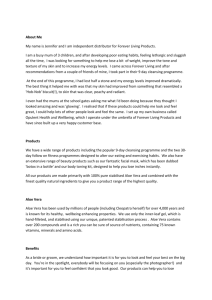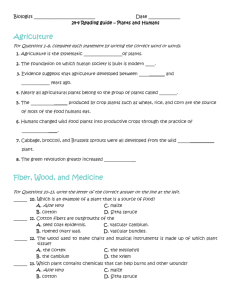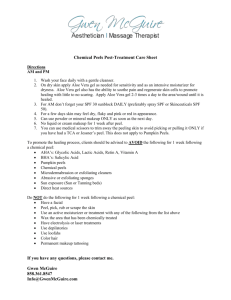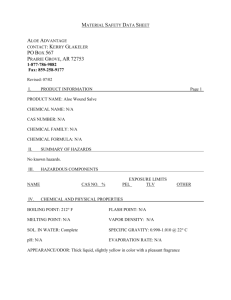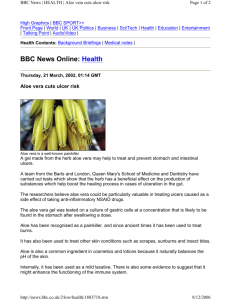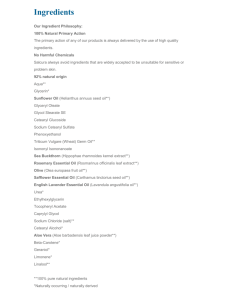Document 13310127
advertisement
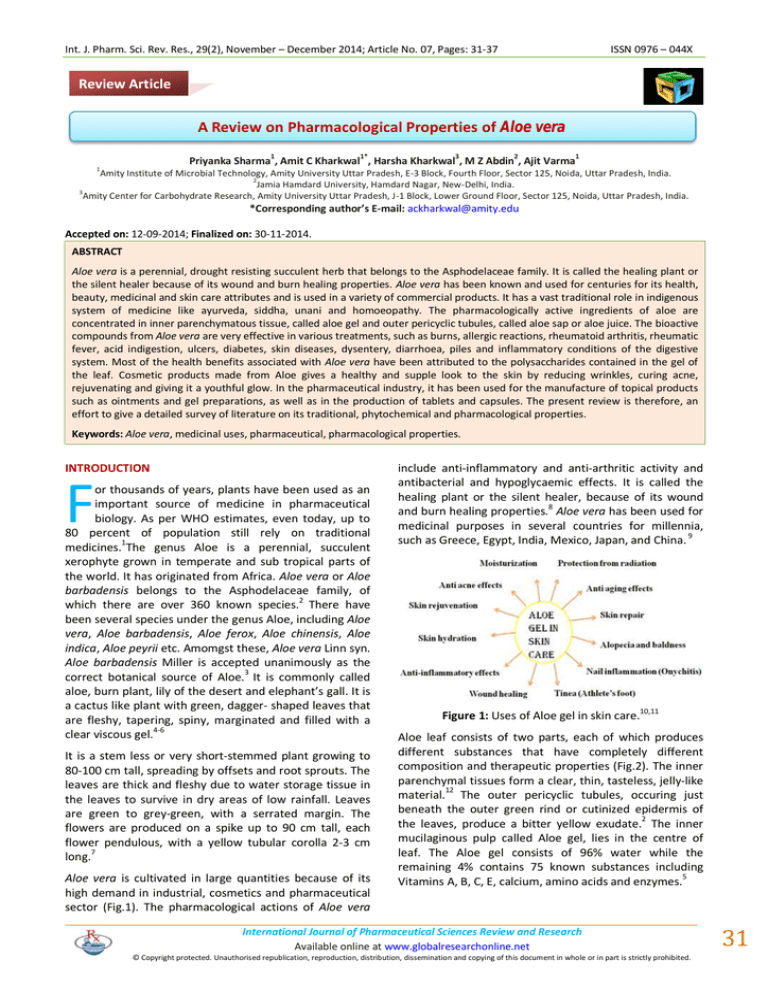
Int. J. Pharm. Sci. Rev. Res., 29(2), November – December 2014; Article No. 07, Pages: 31-37 ISSN 0976 – 044X Review Article A Review on Pharmacological Properties of Aloe vera 1 1* 3 2 Priyanka Sharma , Amit C Kharkwal , Harsha Kharkwal , M Z Abdin , Ajit Varma 1 1 Amity Institute of Microbial Technology, Amity University Uttar Pradesh, E-3 Block, Fourth Floor, Sector 125, Noida, Uttar Pradesh, India. 2 Jamia Hamdard University, Hamdard Nagar, New-Delhi, India. 3 Amity Center for Carbohydrate Research, Amity University Uttar Pradesh, J-1 Block, Lower Ground Floor, Sector 125, Noida, Uttar Pradesh, India. *Corresponding author’s E-mail: ackharkwal@amity.edu Accepted on: 12-09-2014; Finalized on: 30-11-2014. ABSTRACT Aloe vera is a perennial, drought resisting succulent herb that belongs to the Asphodelaceae family. It is called the healing plant or the silent healer because of its wound and burn healing properties. Aloe vera has been known and used for centuries for its health, beauty, medicinal and skin care attributes and is used in a variety of commercial products. It has a vast traditional role in indigenous system of medicine like ayurveda, siddha, unani and homoeopathy. The pharmacologically active ingredients of aloe are concentrated in inner parenchymatous tissue, called aloe gel and outer pericyclic tubules, called aloe sap or aloe juice. The bioactive compounds from Aloe vera are very effective in various treatments, such as burns, allergic reactions, rheumatoid arthritis, rheumatic fever, acid indigestion, ulcers, diabetes, skin diseases, dysentery, diarrhoea, piles and inflammatory conditions of the digestive system. Most of the health benefits associated with Aloe vera have been attributed to the polysaccharides contained in the gel of the leaf. Cosmetic products made from Aloe gives a healthy and supple look to the skin by reducing wrinkles, curing acne, rejuvenating and giving it a youthful glow. In the pharmaceutical industry, it has been used for the manufacture of topical products such as ointments and gel preparations, as well as in the production of tablets and capsules. The present review is therefore, an effort to give a detailed survey of literature on its traditional, phytochemical and pharmacological properties. Keywords: Aloe vera, medicinal uses, pharmaceutical, pharmacological properties. INTRODUCTION F or thousands of years, plants have been used as an important source of medicine in pharmaceutical biology. As per WHO estimates, even today, up to 80 percent of population still rely on traditional medicines.1The genus Aloe is a perennial, succulent xerophyte grown in temperate and sub tropical parts of the world. It has originated from Africa. Aloe vera or Aloe barbadensis belongs to the Asphodelaceae family, of which there are over 360 known species.2 There have been several species under the genus Aloe, including Aloe vera, Aloe barbadensis, Aloe ferox, Aloe chinensis, Aloe indica, Aloe peyrii etc. Amomgst these, Aloe vera Linn syn. Aloe barbadensis Miller is accepted unanimously as the correct botanical source of Aloe.3 It is commonly called aloe, burn plant, lily of the desert and elephant’s gall. It is a cactus like plant with green, dagger- shaped leaves that are fleshy, tapering, spiny, marginated and filled with a clear viscous gel.4-6 It is a stem less or very short-stemmed plant growing to 80-100 cm tall, spreading by offsets and root sprouts. The leaves are thick and fleshy due to water storage tissue in the leaves to survive in dry areas of low rainfall. Leaves are green to grey-green, with a serrated margin. The flowers are produced on a spike up to 90 cm tall, each flower pendulous, with a yellow tubular corolla 2-3 cm 7 long. Aloe vera is cultivated in large quantities because of its high demand in industrial, cosmetics and pharmaceutical sector (Fig.1). The pharmacological actions of Aloe vera include anti-inflammatory and anti-arthritic activity and antibacterial and hypoglycaemic effects. It is called the healing plant or the silent healer, because of its wound and burn healing properties.8 Aloe vera has been used for medicinal purposes in several countries for millennia, such as Greece, Egypt, India, Mexico, Japan, and China. 9 Figure 1: Uses of Aloe gel in skin care.10,11 Aloe leaf consists of two parts, each of which produces different substances that have completely different composition and therapeutic properties (Fig.2). The inner parenchymal tissues form a clear, thin, tasteless, jelly-like material.12 The outer pericyclic tubules, occuring just beneath the outer green rind or cutinized epidermis of 2 the leaves, produce a bitter yellow exudate. The inner mucilaginous pulp called Aloe gel, lies in the centre of leaf. The Aloe gel consists of 96% water while the remaining 4% contains 75 known substances including 5 Vitamins A, B, C, E, calcium, amino acids and enzymes. International Journal of Pharmaceutical Sciences Review and Research Available online at www.globalresearchonline.net © Copyright protected. Unauthorised republication, reproduction, distribution, dissemination and copying of this document in whole or in part is strictly prohibited. 31 Int. J. Pharm. Sci. Rev. Res., 29(2), November – December 2014; Article No. 07, Pages: 31-37 ISSN 0976 – 044X Figure 3: The picture depicts various products made from Aloe gel. Figure 2: The picture depicts the extraction of Aloe gel and the anthraquinone ‘aloin’ (a) Six month old Aloe vera plant (b) leaf detached with the help of scalpel. Aloe leaf contain two main constituents: (c) the yellow brown sap exudating from the cut portion, and (d) upon freeze drying forms a dark brown powder, called aloin, one of the secondary metabolites of Aloe vera. Secondly, (e,f) the Aloe gel, an important constituent of most of the cosmetic products and therapeutics. Many of the medicinal effects of aloe leaf extract have been attributed to the polysaccharides found in the inner leaf parenchymatous tissue.13,14 Aloe gel is used as a moisturizing agent and for the treatment of minor burns, skin abrasions, and irritations (Fig.3). Aloe vera gel has been used to treat gingivitis and been effective against herpes simplex virus.12,15 Second component of Aloe leaf is outer pericyclic tubule that produce an exudate which consists of bitter reddish yellow latex with powerful laxative properties and is available commercially.16 Its bitterness is due to the presence of aloin, aloe-emodin and related compounds.5 The bio active compounds of Aloe are used as astringent, haemostatic, antidiabetic, antiulcer, anti-septic, antibacterial, anti inflammatory, antioxidant and anticancer agent. They are also effective in treating stomach ailments, gastrointestinal problems, skin diseases, constipation, radiation injury, wound healing, burns, dysentery, and diarrhoea and in the 17-20,5 treatment of skin diseases. Aloe vera is called Ghrit Kumari in Sanskrit. It has been described in Ayurveda as a multi functional herb, as a blood purifier, anti- inflammatory, diuretic, uterine tonic, spermatogenic, laxative and fever reliever. It has also been used in Ayurveda for appetite-stimulant, purgative, and for cough, cold, piles, debility, dyspnoea, asthma and jaundice.5 Aloe vera enjoys a great degree of popularity21 and is used in a wide variety of products including cosmetics, creams and toiletries (Fig.3).22 It is one of the most commercialised aloe species and processing of the leaf pulp has become a major industry. In the food industry, it has been used as a source of functional foods and as an ingredient for the production of health drinks and beverages. In the cosmetics and toiletry products, it is used as base material for the production of creams, lotions, soaps, shampoos, facial cleansers and other products. In the pharmaceutical industry, it is used for the manufacturing of topical products such as ointments and gel preparations, as well as in the production of tablets and capsules.23,24,14 A. vera gel may be employed to effectively deliver poorly absorbable drugs through the oral route of drug administration, due to its absorption enhancing effects. Hence, dried aloe gel has been successfully used to manufacture directly compressible matrix type tablets.25,14 The polysaccharides present in the Aloe gel are not stable and hence degrade under stress conditions such as heat, 26 presence of acid and enzymatic activities. Therefore, the production process has to be standardised in order to 26,14 preserve the natural biological activity of the aloe gel. GEL CONSTITUENTS The chemical composition of the Aloe vera gel is complex. Aloe vera contains 75 potentially active constituents: vitamins, enzymes, minerals, sugars, lignin, saponins, 27,2 salicylic acids, and amino acids (Fig.4). The detail is as follows: Vitamins: The plant contains many vitamins, including Vitamins A, C and E, which are antioxidants. It also contains thiamine, niacin, riboflavin, vitamin B12, choline 28 and folic acid. Antioxidant neutralizes free radicals. Enzymes: Amylases, lipases, alkaline phophatases, cellulases, catalases and peroxidases are biochemical catalysts that help in digestion by breaking down fats and sugars. Carboxy peptidases and bradykinases, produce an International Journal of Pharmaceutical Sciences Review and Research Available online at www.globalresearchonline.net © Copyright protected. Unauthorised republication, reproduction, distribution, dissemination and copying of this document in whole or in part is strictly prohibited. 32 Int. J. Pharm. Sci. Rev. Res., 29(2), November – December 2014; Article No. 07, Pages: 31-37 ISSN 0976 – 044X 5,29 Saponins: These are the soapy substances that have cleansing and antiseptic properties.29 Minerals: Sodium, potassium, calcium, magnesium, selenium, manganese, copper, zinc, chromium and iron are all found in the aloe plant. These minerals play an important role in functioning of enzymes, involved in various metabolic pathways. Few of these, act as antioxidants.29 The present review focuses on the phytochemical, pharmacological and traditional uses of Aloe vera. anti inflammatory effect by inactivating bradykinins. Lectins give anti tumour effects.7 Figure 4: Components of Aloe vera leaf. Sugars: Sugars are located in the mucilaginous layer of the plant under the rind of the leaf. It includes monosaccharides (glucose and fructose) and polysaccharides (glucomannose and polymannose). The polysaccharides act as immune modulators.30,7 Glumannan is a good moisturizer and used in cosmetic products.3 Anthraquinones: The bitter reddish yellow exudates, located beneath the outer green rind, contains anthraquinones and their derivatives, Barbaloin, aloeemodin-9-anthrone, lsobarbaloin, Anthrone-C-glycosides and chromones. These are phenolic compounds, traditionally known as laxatives. These compounds exert a powerful purgative effect, when in large amount, but when smaller they appear to aid absorption from the gut and are potent antimicrobial agents and possess powerful analgesic effects.5 Sterols: These include cholesterol, Campesterol, βSitosterol and Lupeol. All these have anti- inflammatory action and lupeol also possesses antiseptic and analgesic 28,29 properties. Hormones: Auxins and gibberellins that help in wound healing and have anti-inflammatory action. Salicylic acid: This is an aspirin-like compound possessing anti inflammatory and antibacterial properties Amino acids: Aloe vera gel provides the amino acids required for repair and growth. It includes 20 of 22 nonessential amino acids and 7 of 8 essential ones.5 Lignin: It is an inert substance which when included in topical preparations, enhances penetrative effect of the other ingredients into the skin.29 PHARMACOLOGICAL PROPERTIES OF ALOE GEL Burn and wound healing property Aloe vera is best known for its soothing and healing effects on burn and other wounds. Aloe vera when applied to a wound increases both the rate of wound closure and the tensile strength of the wound via the proliferation of cells (Fig.5).7 It does so by accelerating the flow of blood towards the wounded area. Aloe is the best 31 wound dressing ever discovered. The mechanism explained behind this acceleration is as follows: Aloe vera gel increases the collagen content and extent of collagen cross linking of the wound, resulting in enhanced wound contraction and breakage of scar tissue.32,33 Chithra et 34 al. also reported the enhancement in content of hyaluronic acid and dermatan sulphate in the granulating tissue of healing wound.29 A 5.5 kDa glycoprotein, isolated from A. vera showed an increase in epithelial cell migration and enhanced wound healing process in a human keratinocyte monolayer.35 Figure 5: Application of Aloe gel brings about the migration and proliferation of fibroblast cells to the wounded area. The growth factors in Aloe are attracted towards the wound and bind to fibroblast IGF receptors. This further enhances the collagen content and cross linking. Thus, increasing the tensile strength of the wound. Moisturizing and anti-aging effect Aloe vera is currently utilized in manufacturing more than 95 % of the dermatologically valuable products. This is because it possesses implausible moisturizing properties. It improves the ability of skin to hydrate itself and help in removal of dead skin cells. It does so, by producing collagen and elastin fibers, making the skin more elastic and less wrinkled, thereby, reversing the degenerative skin changes. It softens the skin, by its cohesive action on superficial flaking epidermal cells and also by the action of amino acids.29,36 For such incredible characteristics, International Journal of Pharmaceutical Sciences Review and Research Available online at www.globalresearchonline.net © Copyright protected. Unauthorised republication, reproduction, distribution, dissemination and copying of this document in whole or in part is strictly prohibited. 33 Int. J. Pharm. Sci. Rev. Res., 29(2), November – December 2014; Article No. 07, Pages: 31-37 Aloe vera is an ideal ingredient in cosmetics and dermatological procedures. Immune System Restoration Aloe vera has been reported to protect the skin against 37,38 damage caused by radiation. It is hypothesized that the administration of Aloe vera gel results in generation of an antioxidant protein metallothionein, which act as a scavenger for hydroxy radicals, hence protecting the skin from oxidative damage. It also releases immunosuppressive Interleukin IL-10, thereby preventing UV induced suppression of delayed type hypersensitivity.39 Anti inflammatory action Inflammation is an innate response of the body against an injury, characterized by swelling, pain, redness and heat, resulting in delay in the healing process. The anti inflammatory action of Aloe vera gel not only relieves from pain and discomfort, but also accelerates the healing process. The effects observed for acetylated mannan in Aloe gel resembles the anti inflammatory action of mannose-6-phosphate.14 Aloe vera also inhibits the cyclooxygenase pathway, reducing the production of prostaglandins, thereby reducing the inflammation.40,29 In a study conducted by Vazquez et al.,41 the aqueous and chloroform extracts of Aloe vera were found to have anti oedema effects. Further, they were found to decrease the neutrophil count progressing towards the peritoneal cavity. A. vera also showed a great anti inflammatory potential for the treatment of H. Pylori infection.42 ISSN 0976 – 044X 44 formation of benzo[α]pyrene- DNA adducts. The mechanism of action proposed for anti cancer effects of aloe polysaccharides is stimulation of immune 21,14 response. The Aloe gel has been found to play an important role in chemoprevention, by causing the induction of glutathione S transferase and an inhibition of tumour promoting effect of phorbol myristic acetate.47,48 Anti-oxidant effects Aloe vera possesses enormous antioxidant effect. Glutathione peroxidise activity, superoxide dismutase enzymes and a phenolic anti-oxidant were found to be present in A. vera gel, which may be responsible for these 49,14 anti-oxidant effects (Fig.6). A. vera enhances the blood quality, probably by allowing the blood to more effectively transport oxygen and nutrients to the cells of body. Immunomodulatory effects 50 Jyotsana et al. showed a significant increase in total white blood cell and macrophage count upon administration of Aloe vera extract. The immunomodulatory activities of the polysaccharides of Aloe vera have been attributed to activation of macrophage cells to generate nitric oxide, secrete cytokines (e.g. tumour necrosis factor-alpha or TNF-α, interleukin-1 or IL-1, interleukin-6 or IL-6 and interferon-γ or INF-γ) and present cell surface markers.51-53 Some immunomodulatory effects were shown to be associated with glycoproteins, namely lectins, found in aloe gel.14 Anti-diabetic effects Aloe vera gel is well known for reducing the blood sugar level. However, the results may vary based on the differences in seperation of mucilaginous layer from anthraquinones.40 It not only lowers the blood glucose level, but also reduces hepatic transaminases, plasma and tissue cholesterol, triglycerides, free fatty acids and phospholipids.14 In a study conducted by Rajasekaran et al.,43 the treatment of gel extract could restore the decreased plasma levels of high density lipoproteins and increased levels of low density lipoprotein to normal levels. The mechanism behind lowering of blood gucose levels could be enhancement of glucose metabolism or it could also be attributed to the anti oxidant effect, which reduces the peroxide levels and hence oxidative damage.44 Aloe vera gel significantly lowered the triglycerides level.45 This explains its hypoglycaemic and hypolipidemic effects.5 Anti mutagenic effects Glycoprotein and polysaccharide (acemannan) fractions 40 of Aloe possess anti tumour activity. The co treatment of Aloe vera was found effective for reducing the genotoxicity of the direct- acting mutagen, in a study 46 conducted by Stanic on adult drosophila. The polysaccharide fraction of Aloe gel showed chemo preventative and anti-genotoxic effects by preventing the Figure 6: Role of antioxidants in scavenging free radicals. ROS stands for reactive oxygen species. Anti bacterial/ anti fungal/ anti viral actions The antibacterial action of Aloe vera gel enhances the 54 wound healing process by its anti inflammatory action. Streptoccocus pyogenes and Streptococcus faecalis are the two micro organisms inhibited by Aloe gel.55,56 Aloe gel acts against both gram positive and gram negative bacteria.57 It possesses bactericidal action against Pseudomonas aeruginosa.58,59 Leaf pulp and liquid fraction of Aloe vera acts against plant pathogenic fungi.5 International Journal of Pharmaceutical Sciences Review and Research Available online at www.globalresearchonline.net © Copyright protected. Unauthorised republication, reproduction, distribution, dissemination and copying of this document in whole or in part is strictly prohibited. 34 Int. J. Pharm. Sci. Rev. Res., 29(2), November – December 2014; Article No. 07, Pages: 31-37 Aloe gel preparation is also inhibitory to Candida albicans.55 Lectin containing fraction of Aloe gel directly inhibits the growth of Cytomegalovirus, by intrerfering 60 the protein synthesis. The anthraquinone derivatives of Aloe leaf have shown virucidal effects on enveloped viruses.61,62 Aloe emodin inactivates most of the viruses, including Varicella zoster, influenza and pseudorabies virus and herpes simplex viruses.61,57 Prof. Dr. (Mrs.) Balvider Shukla, Vice Chancellor, Amity University Uttar Pradesh for their constant support and guidance. REFERENCES 1. Yates A, Yates Garden Guide, Harper Collins Australia, Australia, 2002. 2. Vogler B, Ernst E, Aloe vera: a systematic review of its clinical effectiveness, British Journal of General Practice, 49(447), 1999, 823–828. 3. Chandegara VK, Varshney AK, Aloe vera L. Processing and products: A review. International Journal of Medicinal and Aromatic Plants 3(4), 2013, 492-506. 4. Cheesbrough M, Medical laboratory manual for tropical countries, 260, Butterworth, Oxford, 2000. 5. Joseph B, Raj SJ, Pharmacognostic and phytochemical properties of Aloe vera linn –an overview, International Journal of Pharmaceutical Sciences Review and Research, 4(2), 2010, 106-110. 6. Manvitha K, Bidya B, Aloe vera: a wonder plant its history, cultivation and medicinal uses, Journal of Pharmacognosy and Phytochemistry, 2(5), 2014, 85-88. 7. Kumar KPS, Bhowmik D, Chiranjib and Biswajit, Aloe vera: A Potential Herb and its Medicinal Importance, Journal of Chemistry and Pharmaceutical Research, 2(1), 2010, 21-29. 8. Choi S, Chung MH, A review on the relationship between Aloe vera components and their biologic effects, Seminars in Integrative Medicine, 1, 2003, 53-62. 9. Marshall JM, Aloe vera gel: What is the evidence? , The Pharmaceutical Journal, 24, 1990, 360-362. Effect on gastric acid secretion and ulcers A. vera gel has the ability to cure gastric ulcers or protect against its formation in both animals and humans. The anti-ulcer activities of A. vera have been attributed to several possible mechanisms including its antiinflammatory properties, healing effects, mucus stimulatory effects, regulation of gastric secretions and 14 presence of lectins. The lectins inhibit aminopyrine uptake by parietal cells. Thus, this peculiar ability of the extract to inhibit gastric acid output could be a result of direct action on the acid producing cells.63 Arthritis, Joint and Muscle Pain Studies have found that ingestion of Aloe vera on a daily basis can help prevent and cause a regression of arthritis. Aloe gel also reduces pain related to tendinitis and injuries. When applied directly to the area of pain, Aloe vera penetrates the skin to soothe the pain. Biological Vehicle: Acts as a biological vehicle to aid penetration and absorption of other bio- active ingredients into deep tissue.29 Laxative effects ISSN 0976 – 044X Anthraquinones present in Aloe act as a potent laxative. It increases intestinal water content, stimulates mucus secretion and increases intestinal peristalsis. 10. Basmatker G, Jais N and Daud F, Aloe vera: a multifunctional cosmetic ingredient, International Journal of Medicinal and Aromatic Plants, 1(3), 2011, 338-341. Antiseptic effect 11. Rajeswari R, Umadevi M, Sharmila Rahale C, Pushpa R, Selvavenkadesh S, Sampath Kumar KP, Bhowmik D, Aloe vera: The Miracle Plant Its Medicinal and Traditional Uses in India, Journal of Pharmacognosy and Phytochemistry, 1(4), 2012, 118-124. Aloe vera contains 6 antiseptic agents: Lupeol, salicylic acid, urea nitrogen, cinnamonic acid, phenols and sulfur. They all have inhibitory action on fungi, bacteria and viruses.29 CONCLUSION Aloe vera is a medicinal plant that has been used since ages for its diverse therapeutic properties. The chemical composition of Aloe vera is particularly interesting as several of its components have therapeutic and pharmacological properties. The cultivation of Aloe vera has acquired great commercial importance for medicinal products and cosmetics. Farmers in India regularly face problems like lack of rain, low ground water level, soil degradation etc. Aloe vera is cultivable in diverse ecological habitats and its cultivation can provide regular income and high returns on investment. Acknowledgement: Authors are thankful to Dr. Ashok K Chauhan, Founder President, Ritanand Balved Educational Foundation for suppot. They are also thankful to Shri. Atul Chauhan, Chancellor, Amity University Uttar Pradesh and 12. Tarro VE, The honest herbal: A sensible guide to the use of rd herbs and related remedies 3 ed., Pharmaceutical Products Press, New York, 1993, 25-28. 13. Ni Y, Turner D, Yates KM, Tizard I, Isolation and characterisation of structural components of Aloe vera L. leaf pulp, International Immunopharmacology, 4, 2004, 1745-1755. 14. Hamman JH, Composition and Applications of Aloe vera Leaf Gel, Molecules, 13, 2008, 1599-1616. 15. Krinsky DL, Hawkins EB, Pelton R, Willis NA, Lavalle JB, nd Natural therapeutics pocket guide, 2 ed., Lexi-Comp, Inc, Cleveland, 2003, 379. 16. Wynn RL, Aloe vera gel: Update for dentistry, Pharmacology today: General dentistry, 1(4), 2005, 6-9. 17. Yongchaiyudha S, Rungpitarangsi V, Bunyapraphatsara N, Chokechaijaroenporn, Antidiabetic activity of Aloe vera L juice, I, Clinical trial in new cases of diabetes mellitus, Phytomedicine, 3, 1996, 241–243. International Journal of Pharmaceutical Sciences Review and Research Available online at www.globalresearchonline.net © Copyright protected. Unauthorised republication, reproduction, distribution, dissemination and copying of this document in whole or in part is strictly prohibited. 35 Int. J. Pharm. Sci. Rev. Res., 29(2), November – December 2014; Article No. 07, Pages: 31-37 18. Bunyapraphatsara N, Yongchaiyudha S, Rungpitarangsi V, Chokechaijaroenporn, Antidiabetic activity of Aloe vera L juice, II, Clinical trial in diabetes mellitus patients in combination with glibenclamide, Phytomedicine, 3, 1996, 245– 248. 19. Hirat T, Suga T, The efficiency of aloe plants, chemical constituents and biological activities, Cosmetics and toiletries, 98, 1983, 105-108. 20. Rabe T and Staden JV, Antibacterial activity of South African plants used for medicinal purposes, Journal of Ethnopharmacology, 56(1), 1997, 81-87. 21. Steenkamp V, Stewart MJ, Medicinal applications and toxicological activities of Aloe products, Pharmaceutical Biology, 45, 2007, 411-420. 22. Dat AD, Poon F, Pham KBT, Doust J, Aloe vera for treating acute and chronic wounds, Cochrane database of systematic reviews, 2, 2012, 1-24. 23. Eshun K, He Q, Aloe vera: A valuable ingredient for the food, pharmaceutical and cosmetic industries – A review, Critical Reviews in Food Science and Nutrition, 44(2), 2004, 91-96. 24. He Q, Changhong L, Kojo E, Tian Z, Quality and safety assurance in the processing of Aloe vera gel juice, Food Control, 16(2), 2005, 95-104. 25. Jani GK, Shah DP, Jain VC, Patel MJ, Vithalan DA, Evaluating mucilage from Aloe Barbadensis Miller as a pharmaceutical excipient for sustained-release matrix tablets, Pharmaceutical Technology, 31, 2007, 90-98. ISSN 0976 – 044X dermal wounds in rats, Journal of Ethnopharmacology, 59, 1998b, 179-186. 35. Choi SW, Son BW, Son YS, Park YI, Lee SK, Chung MH, The wound healing effect of a glycoprotein fraction isolated from Aloe vera, British Journal of Dermatology, 145(4), 2001, 535-545. 36. West DP, Zhu YF, Evaluation of Aloe vera gel gloves in the treatment of dry skin associated with occupational exposure, American Journal of Infection Control, 31, 2003, 40-42. 37. Roberts DB, Travis EL, Acemannan-containing wound dressing gel reduces radiation-induced skin reactions in C3H mice, International Journal of Radiation Oncology Biology Physics, 32, 1995, 1047-1052. 38. Sato Y, Ohta S, Shinoda M, Studies on chemical protectors against radiation XXXI: Protective effects of Aloe arborescens on skin injury induced by x-irradiation, Yakugaku Zasshi, 110(11), 1990, 876-884. 39. Byeon S, Pelley R, Ullrich SE, Waller TA, Bucana CD, Strickland FM, Aloe barbadensis extracts reduce the production of interleukin-10 after exposure to ultraviolet radiation, Journal of Investegative Dermatology, 110, 1988, 811-817. 40. Reynolds T, Dweck AC, Aloe vera leaf gel: a review update, Journal of Ethnopharmacology, 68, 1999, 3- 37. 41. Vazquez B, Avila G, Segura D, Escalante B, Antiinflammatory activity of extracts from Aloe vera gel, Journal of Ethnopharmacology, 55, 1996, 69-75. 26. Turner CE, Williamson DA, Stroud PA, Talley DJ, Evaluation and comparison of commercially available Aloe vera L. products using size exclusion chromatography with refractive index and multi-angle laser light scattering detection, International Immunopharmacology, 4, 2004, 1727-1737. 42. Prabjone R, Thong-Ngam D, Wisedopas N, Chatsuwan T, Patumraj S, Anti-inflammatory effects of Aloe vera on leukocyte-endothelium interaction in the gastric microcirculation of Helicobacter pylori-infected rats, Clinical Hemorheology and Microcirculation, 35, 2006, 359366. 27. Atherton P, Aloe vera revisited, British Journal of Phytotherapy, 4, 1998, 176-183. 43. Rajasekaran S, Ravi K, Sivagnanam K, Subramanian S, Beneficial effects of Aloe vera leaf gel extract on lipid profile status in rats with streptozotocin diabetes, Clinical and Experimental Pharmacology and Physiology, 33(3), 2006, 232-237. 28. Coats BC, The Silent Healer, A Modern Study of Aloe vera, Texas, Garland, 1979. 29. Surjushe A, Vasani R, Saple DG, Aloe Vera: A short review, Indian Journal of Dermatology, 53(4), 2008, 163-166. 30. Green P, Aloe vera extracts in equine clinical practice, Veterinary Times, 26(9), 1996. 31. West, Dennis P, Ya Fen Zhu, Evaluation of Aloe vera gel gloves in dry skin associated with occupational exposure, American Journal of Infection Control, 31(1), 2003, 40-42. 32. Chithra R Sajithlal GB, Chandrakasan G, Influence of Aloe vera on collagen characteristics in healing dermal wounds in rats, Molecular and Cellular Biochemistry, 181, 1998a, 71-76. 33. Heggers J, Kucukcelebi A, Listengarten D, Stabenau J, Ko F, Broemeling LD, Robson MC, Winters WD, Beneficial effect of aloe on wound healing in an excisional wound model, Journal of Alternative and Complementary Medicine, 2(2), 1996, 271-277. 34. Chithra P, Sajithlal G, Chandrakasan G, Influence of Aloe vera on the glycosaminoglycans in the matrix of healing 44. Boudreau MD, Beland FA, An evaluation of the biological and toxicological properties of Aloe barbadensis (miller), Aloe vera, Journal of environmental science and health, Part C, Environmental carcinogenesis and ecotoxicology reviews, 24 (1), 2006, 103–154. 45. Kim K, Kim H, Kwon J, Lee S, Kong H, Im SA, Lee YH, Lee YR, Oh ST, Jo TH, Park YI, Lee CK, Kim K, Hypoglycemic and hypolipidemic effects of processed Aloe vera gel in a mouse model of non- insulin-dependent diabetes mellitus, Phytomedicine, 16(9), 2009, 856-863. 46. Stanic S, Anti-genotoxic effect of Aloe vera gel on the mutagenic action of ethyl methanesulfonate, Archieves of Biological Sciences, 59 (3), 2007, 223-226. 47. Kim HS, Lee BM, Inhibition of benzo [a] pyrene-DNA adduct formation by Aloe barbadensis Miller, Carcinogen, 18(4), 1997, 771-776. 48. Kim HS, Kacew S, Lee BM, In vitro chemopreventive effects of plant polysaccharides (Aloe barbadensis Miller, Lentinus International Journal of Pharmaceutical Sciences Review and Research Available online at www.globalresearchonline.net © Copyright protected. Unauthorised republication, reproduction, distribution, dissemination and copying of this document in whole or in part is strictly prohibited. 36 Int. J. Pharm. Sci. Rev. Res., 29(2), November – December 2014; Article No. 07, Pages: 31-37 edodes, Ganoderma lucidum, and Coriolus vesicolor), Carcinogen, 20(8), 1999, 1637-40. 49. Langmead L, Makins RJ, Rampton DS, Anti-inflammatory effects of Aloe vera gel in human colorectal mucosa in vitro, Alimentary Pharmacology and Therapeutics, 19(5), 2004, 521-527. 50. Madan J, Sharma AK, Inamdar N, Rao HS, Singh R, Immunomodulatory properties of Aloe vera gel in mice, International Journal of Green Pharmacy, 2(3), 2008, 152154. 51. Zhang L, Tizard IR, Activation of a mouse macrophage cell line by acemannan: The major carbohydrate fraction from Aloe vera, Immunopharmacol, 35(2), 1996, 119-128. 52. Chow JTN, Williamson DA, Yates KM, Goux WJ, Chemical characterisation of the immunomodulating polysaccharide of Aloe vera L, Carbohydrate Research, 340(6), 2005, 11311142. 53. Im SA, Oh ST, Song S, Kim MR, Kim DS, Woo SS, Jo TH, Park YI, Lee CK, Identification of optimal molecular size of modified Aloe polysaccharides with maximum immunomodulatory activity, International Immunopharmacology, 5, 2005, 271-279. ISSN 0976 – 044X 56. Robson MC, Heggers JP, Hagstrom WJ, Myth, magic, witchcraft or fact? Aloe vera revisited, Journal of Burn Care and Rehabilitation, 3, 1982, 157-163. 57. Habeeb F, Shakir E, Bradbury F, Cameron P, Taravati MR, Drummond AJ, Gray AI, Ferro VA, Screening methods used to determine the anti-microbial properties of Aloe vera inner gel, Methods, 42(4), 2007, 315-320. 58. Cera LM, Heggers JP, Robson MC, Hagstrom WJ, The therapeutic efficacy of Aloe vera cream (Dermaide Aloe) in thermal injuries: Two case reports, Journal of American Animal Hospital Association, 16, 1980, 768-772. 59. Azghani AO, Williams I, Holiday DB, Johnson AR, A betalinked mannan inhibits adherence of Pseudomonas aeruginosa to human lung epithelial cells, Glycobiology, 5, 1995, 39-44. 60. Saoo K, Miki H, Ohmori M, Winters WD, Antiviral activity of aloe extracts against cytomegalovirus, Phytotherapy Research, 10, 1990, 348-350. 61. Sydiskis RJ, Owen DG, Lohr JL, Rosler KH, Blomster RN, Inactivation of enveloped viruses by anthraquinones extracted from plants, Antimicrobial Agents and Chemotherapy, 35, 1991, 2463-2466. 54. Heggers JP, Kucukcelibi A, Stabenou CJ, Ko F, Broemeling LD, Robson MC, Winters WD, Wound healing effects of aloe gel and other topical antibacterial agents in rat skin, Phytotherapy Research, 9, 1995, 455-457. 62. Alves DS, Pérez-Fons L, Estepa A, Micol V, Membranerelated effects underlying the biological activity of the anthraquinones: emodin and barbaloin, Biochemical Pharmacology, 68(3), 2004, 549-561. 55. Heggers JP, Pineless GR, Robson MC, Dermaide aloe/Aloe vera gel: Comparison of the antimicrobial effects, The American Journal of Medical Technology, 41, 1979, 293294. 63. Bhuvana KB, Hema NG, Patil RT, Review on Aloe vera, International Journal of Advanced Research, 2(3), 2014, 677-691. Source of Support: Nil, Conflict of Interest: None. International Journal of Pharmaceutical Sciences Review and Research Available online at www.globalresearchonline.net © Copyright protected. Unauthorised republication, reproduction, distribution, dissemination and copying of this document in whole or in part is strictly prohibited. 37
